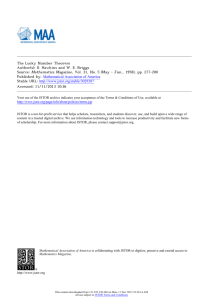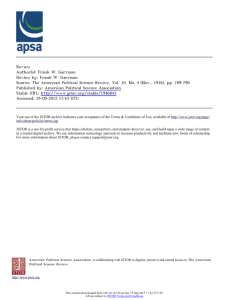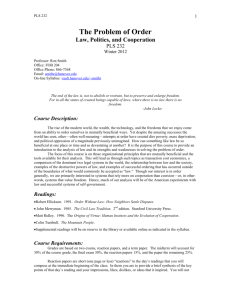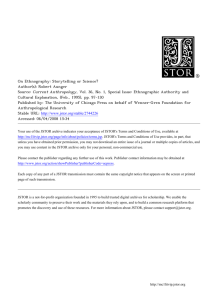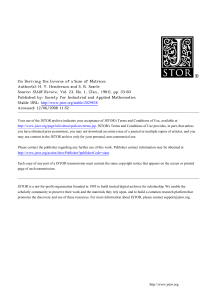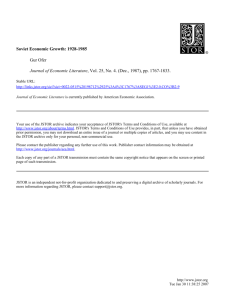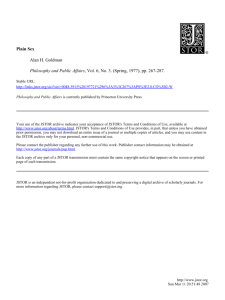"Africa As an Alien Future": The Middle Passage, Afrofuturism, and
advertisement
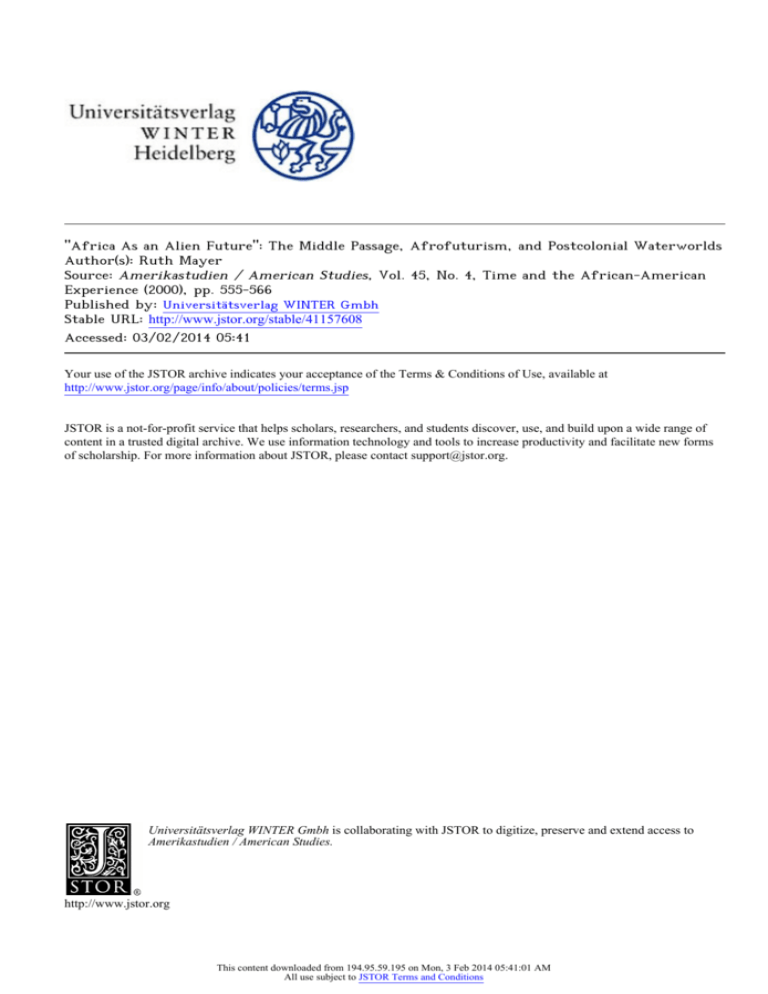
"Africa As an Alien Future": The Middle Passage, Afrofuturism, and Postcolonial Waterworlds Author(s): Ruth Mayer Source: Amerikastudien / American Studies, Vol. 45, No. 4, Time and the African-American Experience (2000), pp. 555-566 Published by: Universitätsverlag WINTER Gmbh Stable URL: http://www.jstor.org/stable/41157608 . Accessed: 03/02/2014 05:41 Your use of the JSTOR archive indicates your acceptance of the Terms & Conditions of Use, available at . http://www.jstor.org/page/info/about/policies/terms.jsp . JSTOR is a not-for-profit service that helps scholars, researchers, and students discover, use, and build upon a wide range of content in a trusted digital archive. We use information technology and tools to increase productivity and facilitate new forms of scholarship. For more information about JSTOR, please contact support@jstor.org. . Universitätsverlag WINTER Gmbh is collaborating with JSTOR to digitize, preserve and extend access to Amerikastudien / American Studies. http://www.jstor.org This content downloaded from 194.95.59.195 on Mon, 3 Feb 2014 05:41:01 AM All use subject to JSTOR Terms and Conditions "AfricaAs an Alien Future": The MiddlePassage,Afrofuturism, and PostcolonialWaterworlds* Ruth Mayer ABSTRACT This paper investigates recentrevisionist of the Middle Passage,enactedin representations and pop music.Most of the textsI explorecan be subsumedunderthe thevisualarts,literature, an artisticand theoreticalmovementwhichhas become a vitalpartof heading'Afrofuturism,' blackdiasporic(pop) culture.Afrofuturist artiststurnto blackhistoryin orderto contemporary recreateit in a markedly fantastic mode.Mixingup theimageryof theMiddlePassage withconand alienation,theyturnthe projectof recutemporary experiencesof displacement, migration, venture. peratingthepastintoa futuristic 1 At one pointin Amistad,StephenSpielberg's1997 filmicepos about the historical revolton the Spanishslaverby thatname,we witnessthe desperateefforts of Cinque (Djimon Hounsou),theleaderof theAfricanrebels,to escape fromtheAmericansoldiers who have come across them.Cinque firsttriesto get away swimming, but is overtakenby a boat. This is when he chooses to take anothercourse,lettinghimself sinkdeeper and deeper into the water,the camera tracinghis driftto the bottomof the sea- a movementwhichis suddenlyand violentlyinterrupted, whenhis body refusesto be drowned,forcingitswayback up to thesurface,whereCinque is promptly pulledintotheboat of hisAmericancaptors. The scene is fascinating because it is bothutterly for hopelessand absurdlyenticing: out is once,Cinque's way obviouslyno way out,his effortat gettingaway a suicidal But on the otherhand,and simultaneously, the scene is repletewithan undertaking. aura of a totalescape,absolutefreedom.Briefly, seems to have driftedintoa Cinque realmwherethelaws of theland do nothold.Of course,once theAfricancomesback to the surface,Spielberg'sfilmsets out to steeran altogetherdifferent course,leaving theunderwater worldand itsstrangelogicbehindand turningto theworldof American law and order.This world,by contrast,is presentedas neat and linear,and it is herewheretheinitialconflict is finallyresolved. *This a follow-upto reflections set forthin my"RevisingSlavery:Contempaperconstitutes poraryBlack Cultureand theTurnto the Past,"Annalsof Scholarship12.3,4(1999): 83-90,and is part of a chapterin my forthcoming book Artificial Áfricas,whichmoves fromHerman Melville's"Benito Cereño" to contemporary of the Middle Passage such as representations StephenSpielberg'sAmistad,CharlesJohnson'sMiddle Passage,and Haile Gerima'sSankofa. Manythanksto Gesa Mackenthunand MarcelReginattofortheircritiqueof earlierversionsof thistext. This content downloaded from 194.95.59.195 on Mon, 3 Feb 2014 05:41:01 AM All use subject to JSTOR Terms and Conditions 556 RuthMayer Withthis,Amistadmanagesto downplaypreciselythe aspectsat the heartof the horrorsof slavery, the factthatthousandsof people were draggedintoa worldwhich could not possiblymake sense to them,and fromwhichtheycould not escape other This is whattheunderwater scene briefly thanat theriskof self-annihilation. captures it one of the film'smostunreal in and it is no accident that the film, presents early scenes.But then,to captureeventsthatwereneverdocumentedin writing by theones thanthe realistones who experiencedthemmightverywell requireanotherstructure All narrativesaroundthe Middle Passage are invariablyand necesof representation. and sarilyspeculative, the moreso today,over one hundredyearsafterthe fact.And or grotesquenarrativesseem so muchmoreadequate to tackle thusfantastic, mythic, theestrangement and angsteruptingin itswake. of theMiddlePassage This is,at anyrate,thecoursea seriesof recentreenactments as take,broughtforthby artistsworkingin mostdiversefields.All of theserevisions, different as theyare,concentrateon thefantasyspaces in-betweenand nowhereat all, The mostobviousof ambivalent, floating. spaces thatpresentthemselvesas mixed-up, thesein-betweenspaces is,of course,the sea, thisparadigmatic space of opennessand connotationsonce it becomes whichgains so radicallycontradictory indeterminacy and revolt.Placed intothecontextof thesettingforabduction,violation,enslavement, theMiddlePassage,theocean becomesthe 'oceanic,'as HortenseSpillersargued:". . . removedfromthe indigenousland and cultureand not-yet'American'either,these captivepersons,withoutnamesthattheircaptorswouldrecognize,were in movement acrosstheAtlantic,buttheywerealso nowhereat all."1 cenWhenreenactedfromtheperspectiveof today,thelastdecades ofthetwentieth of new the theme of ena whole set the Middle connotations, tury, Passage acquires forceddisplacementand violentabductionmergingwithother,more contemporary, scenariosof migration, dislocation,and contact.Paul Gilroy'sstudyThe Black Atlantic to tracethe imageriesof travelin the Africandiaspora,imset out mostimpressively which often enoughmanagedto translatethestarklynegativeintoaccountsof ageries thepastfromthevantagepointofthepresent.2 liberationand self-fashioning, rewriting installationart,pop music- that such arts- literature, It is in the contemporary transformations become mostobvious,and it is here thatthepassagesbetweenAfrica In such reenand the Caribbean are most glaringlyreenacted and transformed. in which "the metaphorof travelis emptiedof a purelyretrospective thrust, actments, the ship is envisionedas the vehicleof an originalabductionor of the returnto an Now the metaphor, youthculturesof the especiallyin contemporary originalterritory. mutaAfricandiasporas,is opened up to harborall kindsof notionsof development, 1 Hortense Spillers,"Mama's Baby,Papa's May-be:An AmericanGrammarBook," Withinthe Circle:An Anthology fromtheHarlemRenaissanceto the ofAfricanAmericanLiteraryCriticism ed. AngelynMitchell(Durham,NC: Duke UP,1994) 454-81,466.On theMiddlePassage Present, see also Wolfgang in AfricanAmericanliterature, Binder,"Uses of Memory:The MiddlePassage in African-American Literature,"Slaveryin the Americas,ed. WolfgangBinder (Würzburg: Königshausen& Neumann,1993) 539-64;Carl Pedersen,"Middle Passages: Representationof the Slave Trade in Caribbean and African-American Literature,"MassachusettsReview 34:2 (1993): 225-39. 1 Cf. Paul and Double Consciousness(London: Verso, Gilroy,The Black Atlantic:Modernity 1993). This content downloaded from 194.95.59.195 on Mon, 3 Feb 2014 05:41:01 AM All use subject to JSTOR Terms and Conditions As anAlienFuture" "Africa 557 tion and crossover."3By consequence,speculationsand fantasiesarise whichmove ceaselesslyback and forththroughtime and space, betweenculturaltraditionsand geographicaltimezones,and thus"betweenAfricaas a lostcontinentin the past and betweenAfricaas an alien future."4 2 "Thereare no storiesof the middlepassage.One hundredmillionpeople were stolen and sold fromtheirhomes,shippedacrosstheworld,and not a singlestoryof that The photographer and installation artistCarrieMae Weemsis very journeysurvives."5 the Middle Passage. To avoid the pitfallsof well aware of the perilsof representing and retrospective exculpation,she focuseson the verylogicof recol'porno-troping'6 in her turnto black history. In an installationconcludedin lectionand reconstruction Island Weems the 1995,Untitled (Sea Series), approaches entangledhistoriesof Africa and America froma markedlycontemporary perspective, juxtaposingphotographs fromthe Gullah Islandsoffthe coast of Georgia and South Caroand folknarratives lina,to presenta pictureof thepastinflectedwiththeknowledgeof thepresent. The bulk of the series consistsof large-format landscape photographscombined withtextpanels.But Weemsalso takesresortto a devicefamiliarfromanotherseries, entitled,tellingly, Commemorating (1992), in whichshe imprinted cheap ceramicdinnerplateswiththenamesof famousAmericans.In herSea Island series,she uses dinner ware to displaygeneral reflectionsabout the projectunder the joint heading "WentlookingforAfrica."One suchdinnerplateinscription reads: f% ! WENT LOOKING FOR AFRICA and foundAfricahere in theproverbs of Mclntosh in thevoices of Sapeto in thesongs of St.Simons Alongthehighways ofJekyll in thegardens ofJohns in thegrave-yards of HiltonHead (WentlookingFor Africa) Fig.1: CarrieMae Weems,Untitled 3 DiedrichDiederichsen,"VerlorenunterSternen:UFOs, Aliens und das GloMothership," balkolorit: Multikulturalismus und Populärkultur, ed. RuthMayerand MarkTerkessidis(St. Andrä-Wördern: Hannibal,1998)237-52;239-40(mytranslation). 4 Kodwo Eshun in an interviewin Last withEdward Angelof History,dir.JohnAkomfrah, Kodwo Eshunand FloydWebb(Death AudioFilmProduction1995). George,researchers: 5 CarrieMae Weemsquotedin MarenStange,"MemoryandFormin RecentAfricanAmerican From12 MillionBlack Voicesto CarrieMae Weems,"unpublished 10-11. Photography: manuscript 0 The term is HortenseSpillers'sand refersto the spectacularenactmentof 'porno-troping blacksuffering and pain foran audiencebothshockedand thrilledbyit.Cf.Spillers67. This content downloaded from 194.95.59.195 on Mon, 3 Feb 2014 05:41:01 AM All use subject to JSTOR Terms and Conditions 558 RuthMayer By dintof thisapproach,Africaand Americaare no longerconceivedof as geographiof beliefs, cal entities,to be neatlyseparated,but as convolutedconcepts,flightlines is enthat are far too intersected to be told Africa and memories, projections apart. in the of its its its soil. Characcore American culture, language, folklore, very grained thedinnerwarefigWeemsexpressesthisinsightbothverballyand formally, teristically, as an emblem of invested with a thatis visibleonly commemoration, uring significance at secondglanceand to theinitiate, as HoustonBakerremarked:"The dishesare memCarrie ory,and theyare luxury.They pass throughgenerationsas familyinheritance. Mae Weemsreclaimssuchceramicsfortheeverydayuses ofculturalconversation."7 The Gullah Islands,once the last illegal resortfor slaveryin the United States, African-American culture:the fact epitomizea centralpredicamentof contemporary thatblack historyis both thereand not there,evidentin countlesstraces,scars,and memories, yet largelysubmergedwhen it comes to writtenaccountsand first-person documentations of the past fromthe viewpointof the victims. To come to pass in its own right,the Africanpresencein the United States has to be pried away fromthe mainstream cultureof whichit has become an integralpart- notby choice,but byneas Samuel Delany pointedout: cessity, . . . untilfairly forbidden as a peoplewe weresystematically recently, anyimagesofour endure conceivable wasmadeto destroy all vestiges ofwhatmight past.. . . everyeffort socialconsciousness. wasfounded on as African When,indeed,we saythatthiscountry we mustremember thatwe mean,specifically, thatitwasfounded on thesystemslavery, ofAfrican Thatsomemusiandmassive destruction cultural remnants. atic,conscientious, andstructures seemto havepersistcal rhythms thatcertain attitudes endured, religious machinwhenyoustudytheefforts ofthewhite, ed,is quiteastonishing, slave-importing erytowipethemout.8 Weems'sseriescan be seen as an effortto remobilizetheseremnantsand drawthem tracesof thepast intonew,ifonlytemporary, unities."9 to our attention, "reassembling The same idea motivateda laterproject,in whichshe documentedthe tracesof New Worldslaveryin WestAfrica.Both projectsevincethatin the fieldof the visualand deviatefromits narrativeartstheprojectof excavatingan Africanpast willinvariably and historiographical premisesand ventureintothe realmof fantasy anthropological and mythto compensateforthe lack of concreteand indubitablematerial.Time and again in the Sea Islandsseries,the rhetoricof historicalfactis replacedwiththe vernacularof personalfantasiesand sense impressions. of two silverprintsand a textpanel,Weems In Untitled(Ebo Landing),a triptych two scenic views of the island St. Simons,framedin black and mountedone displays over the other(fig.2). In betweenthephotographsshe inserteda panel set in circular print: 7 HoustonA. Baker,Jr.,"Islandsof InsidethePicturesof CarrieMae Weems,"Carrie Identity: of AlaMae Weems:In TheseIslands.South-Carolina-Georgia(exhibitioncatalog) (University bama SarahMoodyGalleryof Art,1995) 12-19;16. 8 Mark Dery,"Black to the Future:InterviewswithSamuel R. Delany,Greg Tate,and Tricia 92.4 (Fall 1992):735-78;747. Rose," TheSouthAtlanticQuarterly 9 12. Stange,"Memoryand Formin RecentAfricanAmericanPhotography" This content downloaded from 194.95.59.195 on Mon, 3 Feb 2014 05:41:01 AM All use subject to JSTOR Terms and Conditions "AfricaAs an AlienFuture" 559 EBO LANDING at hightidea One midnight in a cargoof Ebo (Ibo) shipbringing menlandedat DunbarCreekon the Islandof St. Simons.But themenrefused to be sold intoslavery;joininghands togethertheyturnedback towardthe "thewaterbroughtus, water,chanting, thewaterwilltakeus away."Theyall drowned,butto thisdaywhenthe breezesighsoverthemarshesand throughthetrees,youcan hearthe clankof chainsand echo of theirchantat Ebo Landing. Fig.2: CarrieMae Weem,Untitled (Ebo Landing) time Here the Africanpast becomes a ghostlypresent,and a collutionof different forthe detachedand depersonalspheressets in whichis all the more disconcerting of the event.The Ibo men appear in strangeisolation,because ized representation theirenslaversdo not come intoview and because the Africans'desperateact is related not so muchas a tragicgroupsuicidethan as a weirdand movingritual.The photographsemphasizethisaura of timelessdetachmentor suspensionof timeand place:the marshlandat viewa curiousmixtureof waterand earth,and the entiresetup of irregular palm treesand lushvegetationlookingas 'African'as it is 'American.' The Ibos' act seemsto have fundamentally affectedtheland,givingventto a haunting thatis intricately connectedwiththe region'shistory-its functionas a portforslave shipsand its plantationculture-even it or preciselybecause,thishistoryturnsinto fantasyand myth. The same collutionof historyand myth,the repressedcruel past and a seemingly enlightened present,runsthrougha muchearliertextwhichtracesthe horrorsof the MiddlePassage whilewell aware of the impossibility of representing the viewpointof its victims:HermanMelville's"Benito Cereño" (1855).10Afterall, Melville'snovella 10Herman Melville,"Benito Cereño" (1855), Billy Budd, Sailor and Other Stories(Harmondsworth: Penguin,1970)217-307. This content downloaded from 194.95.59.195 on Mon, 3 Feb 2014 05:41:01 AM All use subject to JSTOR Terms and Conditions 560 RuthMayer figuresfortha "spectral marionette show,"11presentingthe slave ship along the lines of gothic horroras a haunted place in the middle of nowhere: Alwaysupon firstboardinga large and populous ship at sea, especiallya foreignone, witha nondescript crewsuchas Lascars or Manillamen,the impressionvariesin a peculiar way fromthatproducedby firstenteringa strangehouse withstrangeinmatesin a strangeland.Both house and ship- the one by its walls and blinds,the otherby its bulwarkslike ramparts-board fromviewtheirinteriors tillthelast moment:but in thecase of theshipthereis thisaddition;thatthe livingspectacleit contains,upon itssuddenand of the has,in contrastwiththeblankocean whichzones it,something completedisclosure, effectof enchantment. The shipseemsunreal;thesestrangecostumes, and faces, gestures, buta shadowytableaujust emergedfromthedeep,whichdirectly mustreceiveback what it gave.12 foreshadow Theseobservations thestory'slaterrevelationofa pervasivemasqueradeenacted on the ship,a revelationwhichleaves no doubt that the phenomenawhich or significant than the "[emerge]fromthe deep," are not necessarilymore truthful "blank"surfacetheydisrupt. To thecontrary, theiruncannyeffect reside might exclusively intheirmeaninglessness, the"spectacle"or "shadowytableau"onlythemorefrightening becauseithas lostanymelodramatic itdoes notpermititselfto be read.13 significance: In fact,itis onlyagainstthebackdropofthehighseas,the'blankocean,'thatthespectacle ofsocial and culturalinteraction under (the "nondescript" foreigncrew,presumably Americanleadership)fullyrevealsitscruel,uncanny, and absurdcharacter.In "Benito notas theland'sopposite,butas itsepitome:heretheincongruiCereño,"thesea figures tiesoftheland- mostnotablythesystemofslavery-are too conspicuousto be entirely whichlikeignored.AndthisiswhereMelville'snovellacallstomindWeems'sinstallation wiseassociatesthesea witha repressedandgruesomepast- theIbos' deathbydrowning. does But whileforMelvillethe'blanksea,'just likethe'tableau' of theland,ultimately notmake sense,because it is an emptymelodramaor tautologicalmasquerade,Weems the sea turnsfromblanknessto turnsit into a meaningful entity.In her enactment, aboutthedead ofslaverymixedup withthemythsofAfricabringing myth-thehistory men'sreturnand theirhauntingtakeover.WhereMelvilledisclosesa dead end,Weems's as a pointofdeparturefora newsymbolic horrorscenariofigures repertoire. Withthis,Weems posits herselffirmlyin a postcolonialscene whichinsistsupon essence and blankness readingestablisheddichotomiesof meaningand insignificance, crew,'or thedrownedones whoseviewagainstthegrain,sidingwiththe 'nondescript anotherconceptof historyand historiogralost,by implementing pointis irretrievably thisnew notionof historyis assoIn "The Sea is Derek Walcott's History," poem phy. ciatedwitha new beginningout of the pain and horrorof the Middle Passage,a new fromthevictims, thedrownedslaves: stemming beginning 11MichaelP. Rogin,SubversiveGenealogy:The Politicsand Artof HermanMelville(Berkeley: U of CaliforniaP,1983) 209. 12Melville221-22. 13On the over and over thatthe signsof ethical logic of melodrama,which"demonstrates forcescan be discoveredand can be made legible,"see PeterBrooks,The Melodramatic Imagination:Balzac, HenryJames,Melodrama,and theMode of Excess (1976; New Haven, CT: Yale UP,1995) 20. This content downloaded from 194.95.59.195 on Mon, 3 Feb 2014 05:41:01 AM All use subject to JSTOR Terms and Conditions "AfricaAs an AlienFuture" 561 Whereare yourmonuments, yourbattles,martyrs? Whereis yourtribalmemory?Sirs, in thatgreyvault.The sea. The sea has lockedthemup.The sea is history Sir it is lockedin themsea-sands out therepastthereefsmoilingshelf, wherethemen-o'-war floateddown; stropon thesegoggles,I'll guideyoutheremyself.14 thattheocean's "blankpages" are notas emptyas theyseem,Walcott'spoem Insisting fashionsthe veryhistoryit then sets out to pronouncein the last line: "in the salt chuckleof therocks/withtheirsea pools,therewas thesound/like a rumorwithout Black diasporichistory, it seems,is a thingof anyecho /of History, reallybeginning."15 thefuture, notof thepast,a subjectof fantasies, dreamsand speculations-thecurrents and changesofthesea- whichis createdin theprocessofitsrecuperation. 'blank.' But Thus,WalcottrefutesMelville'snotionof the ocean as irretrievably even moreimportantly, his turnto the sea as botha burialgroundand the space of a new beginning, just like Weems'senactmentof memoryas survival,indicatesthatthe of itsown,new goggles,ifyou subjectmatterof black historyrequiresa methodology will,thatmake readablewhatseemedblankand revealtheghostsof thepast at loose in the presentworld.It is preciselythe openness and indeterminacy of the sea, its 'oceanic' qualityof the 'nowhereat all' as HortenseSpillershad it,whichprivileges thisspace fora pervasiverevisionfromthe vantagepointof presentneeds and desires.This is whythe underwaterworld,the submarine,gains so much attentionin turn:by contrastto the charteredand mappedhighseas,thisworldbelow emergesas a realmbeneathexistinglines of power and signification, an ambivalentspace, "neitherEuropean nor Caribbean,neithermetropolitan nor colonial,neitherwithinthe 'West' nor withoutit," as Ian Baucom wrote16-a fantasyspace whichis alwaysas muchof thefutureas it is of thepast. 3 We mustnotforgetthatthefuturistic fantasyspaces in blackcultureare alwaysalso of retreat from real ifoftenonlyindirectly-to these spaces very pressures, testifyingand their traumatic effects. "Black live theestrangement thatscience pressures people fictionwritersimagine,"17 Tate and for that matter it is no accident that noted, Greg so muchblackartthatcurrently deals withthis'lifefeeling'is not onlyclearlyfuturistic,but also,and just as clearly, highlymorbid-tellingghoststoriesand talesof haunting.The BritishdirectorJohnAkomfrahthuscast thispeculiarobsessionwiththepast 14Derek Walcott,"The Sea is Poems1965-1980(London:JonathanCape, 1980) 237History," 40; 237,238. 15Walcott238,240. 10Ian Baucom, Culture8.1 (1997): http://muse.jhu. "Chartingthe'Black Atlantic,'"Postmodern lbaucom.html. edu/journals/postmodern_culture/v008/8. 17Mark Dery,"Black to theFuture"767-68. This content downloaded from 194.95.59.195 on Mon, 3 Feb 2014 05:41:01 AM All use subject to JSTOR Terms and Conditions 562 RuthMayer as an obsession with the dead: "I think necrophilia is at the heart of black filmmaking." To come up with a history of one's own against the pull of oblivion and decay-to enforce the returnof the repressed- is to face some ugly truths: is theveryend and the The mostpowerfulmoment,forme,in myearlierfilmTestament, Whenshe goes to whichare bothimagesof death,stultification, atrophy. verybeginning, the graveyardand buriesher father,or when the man walks into the river,whichis a wish-fulfilment of death,a drowningwishgoingon there.There is a level of morbidity Identitiesare a morbidbusiwhichI thinkpeople have to realisein thequest foridentity. ness.18 Of course, Akomfrah's emphasis on a morbid black imagination is, to a certain extent, polemic- pitted against all-too-familiarstylizationsof blackness as mindlesslyjoyful, happy-go-luckyand a-historical.But there is more to the obsession with the alien and the uncanny in black culture than sheer provocation, as Weems's and Walcott's ghost stories exemplify,and as comes even more trenchantlyto the fore in contemporary pop-cultural turns to the Middle Passage and its imagery of travel and displacement. It is in this context, the workings of pop culture,that the spirits and ghosts of yore turn into quite contemporaryfiguresof horror and haunting:aliens, extraterrestrians, creatures fromthe deep. A fetusin itsmother'swombis Could it be possibleforhumansto breatheunderwater? alive in an aquaticenvironment. certainly AfriDuringthegreatestholocausttheworldhas everknown,pregnantAmerica-bound can slaves were thrownoverboardby the thousandsduringlabor forbeingsick and disruptivecargo.Is it possiblethattheycould have givenbirthat sea to babies thatnever neededair? have shownmiceable to breathliquidoxygen.Even moreshocking Recentexperiments and conclusivewas a recentinstanceof a prematurehumaninfantsaved fromcertain deathbybreathing lungs. liquidoxygenthroughitsunderdeveloped of gill men and swampmonstersin the These factscombinedwithreportedsightings UnitedStatesmake the slave tradetheorystartlingly coastalswampsof the Southeastern feasible.19 These are excerptsfromthe linernotes to the album The Quest by the Detroitelectronicduo Drexciya,a projectwhichhas formanyyearsfashioneditselfaroundsimiabout 'Drexciyans'- sea creaturesof a superiorsubmarinecivilization lar ruminations Obviously,this narrativeepitomizesthe invadingthe United States systematically.20 logic sketchedabove, fromthe move to the sea as an alternativehistorydeeply infusedwithfantasyand myth,to the evocationof aliensarisingout of alienation,up to the morbidimageryof creaturesbetweendeath and life and beyondidentification, whichtheentirealbumthensetsout to consolidate. we are given The narrativeof the linernotes is, afterall, the only 'information' and from bits about the album.The musictellsno story, pieces of lyrapart disjointed 18Kass An Interview Banning,"FeedingOffthe Dead: Necrophiliaand the Black Imaginary. 29-30(Winter1993):33. Borderlines withJohnAkomfrah," 19 Drexciya,The Quest(Detroit:Submerge,1997),linernotes. 20For an analysisof the act and its aestheticssee Kodwo Eshun,"Fear of a WetPlanet,"The Wire(January1998): 19-20.I came across Eshun's piece throughLovingtheAlien:ScienceFiced. DiedrichDiederichsen(Berlin:ID Verlag,1998),in whicha Gertion,Diaspora,Multikultur, manversionof thistextappeared. This content downloaded from 194.95.59.195 on Mon, 3 Feb 2014 05:41:01 AM All use subject to JSTOR Terms and Conditions "Africa As anAlienFuture" 563 butdisorientand confuse.Insteadof learnics thatnotso muchadd up to a narrative, about the we are more Drexciyans, literallyforcedinto an underwaterworld,a ing and the natural,bubble tonesand elecsoundpatternmeshingtogetherthe synthetic in morethanone sense.An aesthetics tronicscales whichcould be called breathtaking of alienationtakeshold,as Kodwo Eshun has argued: . . . thereis nosinger, noredemption, nohumantouch. Farfrom electronics, rehumanizing fiction exacerbates thisdehumanization, theworldwithimpalpable Drexciyan populating thatgeton yournerves At LoveParadeandTribalGathering hallucinations youcan musicis universal stillhearDJssaying electronic music. Thefrequencies canuniteus all After ina tonalconsensus. toDrexciya, it'saudiblethatifelectronics everunites, listening thenitdoesso through obfuscation. It communicates through mystification.21 By dint of thisreading,electronicmusiccould become the vehiclefor dissentin a Deleuzian controlsociety,whichoperatesnot "by confining people,but throughcontinuouscontroland instantcommunication."22 Drexciyaseem to complyexemplarily withDeleuze's demandfor"vacuoles of noncommunication, circuitbreakers,"which the Frenchcriticdeemed indispensableto "elude control."23 For Eshun, Drexciya's aestheticsof alienationformsthe blueprintfora new formof culturalinteraction and contact:"Each tracktitle. . . functionsas a componentin an electronicmythology whichthelistenerassembles A new geographyof morals."24 Of course,suchenthusiasmabout thepotentialof musicto bringfortha fundamental disruption, a new mythology, mustalwaysface up to the 'fluidity'of musicalexfact that even when not purelyinstrumental, is so muchmore music, pression-the ambivalentthananyotherartisticmedium,especiallywhenit comesto ideologicalpositionsand projections. It is,afterall,by wayof lyrics, linernotes,performance, and artisticcommentsbothon and offstage thatthisideologicaldimensionentersthe field of music.By consequence,the politicaland social effectsof musicturnout to be a matterof style-highlyunstable,open to all kindsof adaptations, and approrevisions, While I hesitatethus to join into the enthusiasticchorusof criticslike priations.25 Eshun and celebrateelectronicmusicas the manifestation of an altogethernew 'posthuman'formof expression,I do believethatDrexciya'sstylepoliticsare indicativeof an interesting fictionsthat strain turn,as they produce self-destroying narratives, and closure. againsttheconventional pullof identification Seen thatway,theeffectofmystification evokedbyEshunis verywellgivenin Drexdifferent level,as itis inscribedin theveryinteraction ciya,butlocatedon an altogether of instrumental musicand thenarratives aroundit.Whilethenarratives, the presenting 21Eshun,"Fear of a WetPlanet"20. 22GillesDeleuze, "Controland Becoming"(ConversationwithToniNegri,1990),Negotiations, 1972-1990.trans.MartinJoutmin (New York:ColumbiaUP 1995Ì 169-76:174. 23Deleuze 175. 24Eshun,"Fear of a WetPlanet"20. For a moredetaileddiscussionof electronicmusicand its culturalpotential, see Eshun'sMore BrilliantThantheSun:Adventures in Sonic Fiction(London: QuartetBooks,1997). 25On thisissue, especiallywithregardto so-called'protestmusic,'see SimonFrith,Performing Rites:On theValueof PopularMusic (Oxford:OxfordUP, 1996);and my"Pop As a Difference Simulacrum America,ed. ElisabethKraus and Carolin Engine:Music,Markets,and Marginality," Auer(Rochester,NY: CamdenHouse,2000). This content downloaded from 194.95.59.195 on Mon, 3 Feb 2014 05:41:01 AM All use subject to JSTOR Terms and Conditions 564 RuthMayer frombelow,offerpatternsofidentificationif Drexciyansas socialoutcastsand fighters ones- the musictakesthesepatternsapart,movingbetweenrecogmarkedlyfantastic nizablestructures sounds)and purenoiseand thusdiscouraging anyat(theunderwater that cannot sense a code be at eventually, erecting deciphered. tempt making InOf course,Drexciyaare not the firstmusicalact to come up withthisstrategy. back to the free of Ra and their aesthetics can be traced Sun deed, jazz experiments his Arkestra,not only withregardto musical,but also to conceptualdevelopments. Time and again,the space narrativesevoked in thiscontextran analogousin theirefof freejazz to movefromestablishedharmoniesto sudden fectto themusicalstrategy to confront closurewithchaos.Justlike the musicveers between and transgressions so the establishrecognizablestructures and only space narratives signification rupture, to disavowthemin turn:". . . theyhave throwntheirown identitiesintoquestion,takaliasing on a multitudeof costumesand alteregos,each of themis a myth-making, other writes John Corbett on Sun Ra's and shaman," taking,self-styled postindustrial invoked musicians''space madness.'26 By consequence,the aliensand extraterrestrians by so manyblack musicalprojectsof the 1950sand 1960sare not to be understoodas neat inversionsof the dominantvalue system,but as moreextensivetacticsof confusion-instead of "onlyturningaroundthe relationof 'us' against'them,'and otherbinaries,"DiedrichDiederichsenwrote,"mostof theseartiststendto messup theentire matrixof binarydistinctions."27 thistechniqueof 'messingup' has become a In the worksof contemporary artists, muchmorestrategic-and theoretical-affairthanin,say,Sun Ra's fantastical mythology.This comes not onlyto the forein musicalprojectsfromDrexciyato DJ Spooky the fictionof Darius Jamesor the and 4hero,but also in the filmsof JohnAkomfrah, with All of these artof KeithPiper. artists, manymore,have been subsumed together as all of themfocusone way or anotheron the underthe heading"Afrofuturism,"28 intersecting imageriesof pastnessand futurein black culture,settingout not so much deconstruct to rewritethehistoryof the Africandiaspora,butto systematically it,renfilm to the in Akomfrah 's Eshun it John as Kodwo an 'alien Africa future,' put dering Afrofuturmonsters The aliens and Last movement, Angelof History(1995). haunting and realism,collapsingestabist narrativesexplode the confinesof historiography and put forthundecipherablecodes and identification, lishedpatternsof signification and fractured images. One prominentmeans of generatingthe atmosphereof alienationso characteristic sounds imitate In Drexciya'sQuest,synthetic formanyof theseworksis technology. the same,so thatthe underwater naturalones,soundingalmost,but not altogether, 26JohnCorbett,"BrothersfromAnotherPlanet:The Space Madness of Lee 'Scratch'Perry, Sun Ra, and George Clinton,"ExtendedPlay: SoundingOfffromJohnCage to Dr. Funkenstein (Durham,NC: Duke UP, 1994) 7-24;7. 27Diederichsen,"VerlorenunterSternen,"242 (mytranslation). On thisaestheticsand its imto LovingtheAlien,ed. plicationssee, apartfromCorbettand Diederichsen,the contributions Diederichsen, especiallyTobiasNagl's "'I wonderifheaven'sgota ghetto':Aliens,Ethnizitätund der SF-Film,"and Renée Green's "Leidige Liebe: My Alien /My Self- Readingsat Work,"6887, 134-51. 28For a definition to thedevelopand an introduction of the- awkward-term'Afrofuturism' mentat itsoutset,see MarkDery,"Black to theFuture,"735-43. This content downloaded from 194.95.59.195 on Mon, 3 Feb 2014 05:41:01 AM All use subject to JSTOR Terms and Conditions "Africa As an AlienFuture" 565 worlddisclosedseems strangein several respects-a sphereunderneaththe human worldwhichis at thesame timea realmoutsideof nature:artificial, alien,and uncanny. In theworkoftheBritishinstallation artistKeithPiper,similarstrategies oftechnological alienationare employed,and again the resultis thecollapseof long-standing symbolic systems-not in orderto replacethem,but to expose themin theirconstructedness and arbitrariness. And once moreaquaticimagery, or whatKobena Mercercalled the aestheticsof "oceanic feeling,"29 is at the heartof thesetechniquesof alienation, and deconstruction: certainties are setafloat,and stableidentities go downthedrain. time Piper's installationfalls into three parts,all of them opening up different framesto tracethe interrelations betweenblack Britishhistoryand the Africandiasreflectsthe Middle Passage bepora. One such part,"The Ghostsof Christendom," tweenAfricaand the Caribbean,and leaves no doubt that Piper,too, conceivesof black historyas also beingalwaysa horrorstory.The shipcalled Jesusis theJesusof Lübeck,the firstofficialBritishvessel to take part in the slave trade,sent offby forththe intricateconvolutionof religionand Queen Elizabethin 1564,and figuring and ideologyat heartof colonialhistoryand the historyof slavery politics,spirituality on a tombstonedisplayedin the exhibition. likewise,as we learnfroman inscription And yet,religioushistoryis notto be writtenalongthelinesof dominationand subjugationalone,as Piper'sprojectevinces:"[T]he slave shipcalled Jesushas experienced a mutinyof radical proportions. The same Africansforwhichthe ship had been a mechanismof imprisonment had seized controlof thehelmand weresteeringtheship in a totallydifferent direction."30 The exhibition, whichcomprisesa varietyof different representational techniques, unfoldsarounda seriesof hugecomputer-montaged mountedon lighttransparencies boxes to simulatestained-glass churchwindows(fig.3). Here,the obviouslyhigh-tech emulatesthe ancient,the up-to-dateand the traditionalenmeshedwitheach other, whileAfricanand Westernsymbolsand emblemsappear in intimateinterlinkage. This effectis drivenhomemostimpressively in a montageshowingthe feetof a blackcrucifiedbody on a cross-shapedframe,hangingover a water-filled basin witha broken mirrorinside(fig.4). Ian Baucom has read thisinstallationas a strategyof enforcing an impossiblepointof view,anothermeansof pullingus underwater: we see notsimply a reflection of theagonizedblack Lookingdownintothesewaters, as iffrombeneath, frombelowthe bodywhichhangsabove,we see thatbleeding figure surface ofthewater.Manipulating a trickoflightto reverse ouropticofinspection and to reposition ourspaceofobservation, Piper'sinstallation displacestheviewing subject, drawsus beneaththewaterto gazeat thesceneofviolenceplayedoutabove.Thework forces tooccupythesubmarine.31 us,ifonlyfora moment, If thisrelocationof the perspectiveis definitely one effectof the installation, there is more to it.The tormentedblack body on the cross,just like the entireexhibition, 29Kobena Mercer,"Witnessat the Crossroads:An Artist's Journeyin Post-colonialSpace," KeithPiper:RelocatingtheRemains(exhibitioncatalog) (London: Instituteof International Visual Arts,1997) 13-85:79. 30Cf.Keith Ikon Gallery,1991) Piper,A Ship Called Jesus(exhibitioncatalog) (Birmingham: unpaginated. 31Baucom, unpaginated. This content downloaded from 194.95.59.195 on Mon, 3 Feb 2014 05:41:01 AM All use subject to JSTOR Terms and Conditions 566 RuthMayer Fig.3: KeithPiper,A Ship CalledJesus(detail) Fig.4 pointsto a deep skepticismvis-à-visthe verysymbolicsystemsat workhere:the selfwhichtriggeredthe historyof suffering same system-Christianityfiguresnow as a it.Withthis,Piperforonce does inverta set of dominantsigns meansof representing and symbols,as his catalog essay indicates.But he also goes beyondmere inversion, of representing thedifficulty positivelywhathappenedand whathappens pinpointing in the historyof culturalcontactand race relations.Afterall, the installationis not it does not contentwithrelatinga clear-cut'other'storyof salvationand redemption; of the The fractured reflection 'blacken' the of merely imagery Christianity. doubly of suchneat reblackbodywe see in thewaterinsteadbringsabout theshortcomings value systems, versals,whichmerelyturnaroundprefabricated ideologies,and props, of meaningand knowledgethat and thusadd speculationsto speculations:fragments are as brokenup and distortedas the bodyreflectedin the water.Thus Piper'sinstallationseemsto commenton theotherprojectsI presentedhere;all of themcollapsing and mythical historiographical past,present,and future,and all of theminterlinking not so muchin orderto reconstruct a lost history(as did Spielrhetoricand imagery, berg'sAmistad),but to dismantletheestablishedone and givescope to altogetherdifferent, highlyfantasticscenariosinstead,whichare as muchof the futureas theyare of thepast.In anycase we end up withstrangesights-alien,aquatic,artificial-which forceus notonlyto reconsiderthepast,butmostof all thepresentwe like to take for granted. This content downloaded from 194.95.59.195 on Mon, 3 Feb 2014 05:41:01 AM All use subject to JSTOR Terms and Conditions

